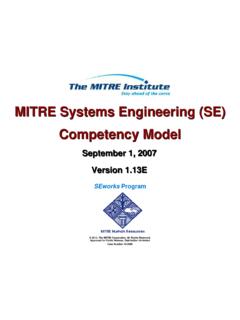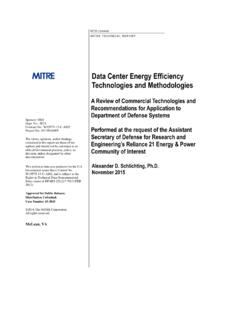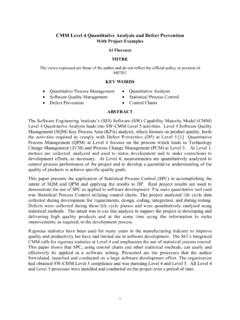Transcription of Cyber Security Governance - Mitre Corporation
1 Cyber Security Governance A Component of Mitre 's Cyber Prep Methodology Deb Bodeau, Steve Boyle, Jenn Fabius-Greene, Rich Graubart September 2010 M T R 1 0 0 3 0 8 M I T R E T E C H N I C A L R E P ORT Sponsor: Dept. No.: G020 Contract No.: Project No.: 01 CCG005-AD The views, opinions and/or findings contained in this report are those of The Mitre Corporation and should not be construed as an official government position, policy, or decision, unless designated by other documentation. 2010 The Mitre Corporation . All Rights Reserved. This page intentionally left blank. iii Abstract Cyber Prep is a conceptual framework, together with a practical methodology, which an organization uses to define and implement its strategy for addressing adversarial threats related to its dependence on cyberspace. In particular, Cyber Prep enables organizations to articulate their strategies for addressing the advanced persistent threat (APT).
2 The Cyber Prep framework defines five levels of organizational preparedness, characterized in terms of The organization s perspective on, and/or assumptions about, the threat it faces; The organization s strategy for addressing the threat, including which adversary tactics, techniques, and procedures (TTPs) it addresses; and The organization s approach to Cyber Security Governance . This white paper presents the Governance component of Cyber Prep. As with the component that addresses technical and operational Security measures, Cyber Prep expects that organizations apply sound principles for information systems Security Governance and make effective use of standards of good practice for Security management. The Cyber Security Governance component of Cyber Prep focuses on what organizations must do differently from or in addition to generally accepted information Security Governance practices in order to address the APT.
3 In Cyber Prep, the five levels of organizational preparedness entail different approaches to Strategic integration. To what extent is the Cyber Security strategy integrated with other organizational strategies? To what extent does the strategy extend beyond the organization? Disciplines. What disciplines are part of, or aligned with, Cyber Security ? Risk mitigation approaches. To what extent does the organization focus on compliance with standards vs. state of the practice Security engineering vs. state of the art? Adaptability / agility of Cyber decision making. To what extent do Governance and decision making address the concern that adversaries may target decision makers and decision processes? Senior engagement. What is the highest level of official or staff member within the organization actively engaged in Cyber Security decision making? Cyber risk analytics. How are threats modeled and risks contextualized and assessed?
4 Iv This page intentionally left blank. v Table of Contents 1 Introduction .. 9 Governance .. 10 Governance and Maturity .. 12 Governance and Organizational Structure .. 12 2 Aspects of Cyber Security 13 Strategic Integration .. 13 Allied Disciplines .. 15 Cyber Risk Mitigation Approach .. 16 Adaptability and Agility .. 17 Senior Engagement .. 18 Cyber Risk Analytics .. 19 3 Assessing an Organization s Cyber Security Governance .. 21 Cyber Prep Level 1 .. 22 Cyber Prep Level 2 .. 23 Cyber Prep Level 3 .. 26 Cyber Prep Level 4 .. 28 Cyber Prep Level 5 .. 30 4 Conclusion .. 33 Appendix A References .. 34 Appendix B Cyber Security Governance and Other Models .. 37 Maturity Models .. 37 SSE-CMM .. 37 BSI- MM .. 37 ISM3 and SOMA .. 38 GRC MM .. 38 PRISMA .. 38 Other .. 39 Governance Models and Frameworks .. 39 Risk Governance Framework.
5 39 Information Security Governance .. 41 Information Security Governance Models and Frameworks .. 41 Information Security Governance and GRC .. 42 Key Principles of Information Security Governance .. 42 vi Information Security Governance Organizational Approaches .. 43 Appendix C Acronyms .. 44 vii List of Tables Table 1. Underlying Organizational Strategies for Cyber Prep Levels .. 11 Table 2. Integration of Cyber Security Strategy with Other Organizational Strategies .. 14 Table 3. Strategic Integration Beyond the Enterprise .. 15 Table 5. Cyber Risk Mitigation Approach .. 17 Table 6. Adaptability and Agility .. 18 Table 7. Senior Engagement in Cyber Security Strategic Decision Making .. 19 Table 8. Cyber Risk Analytics .. 20 Table 9. Governance Assessment 21 Table 10. Characteristics of Cyber Security Governance at Cyber Prep Level 1 .. 22 Table 11. Assessing Conformance with Cyber Prep Level 1 Governance .
6 23 Table 13. Assessing Conformance with Cyber Prep Level 2 Governance .. 25 Table 14. Characteristics of Cyber Security Governance at Cyber Prep Level 3 .. 26 Table 15. Assessing Conformance with Cyber Prep Level 3 Governance .. 27 Table 16. Characteristics of Cyber Security Governance at Cyber Prep Level 4 .. 28 Table 17. Assessing Conformance with Cyber Prep Level 4 Governance .. 29 Table 18. Characteristics of Cyber Security Governance at Cyber Prep Level 5 .. 31 Table 19. Assessing Conformance with Cyber Prep Level 5 Governance .. 32 Table 20. Cyber Security Governance in the IRGC Approach .. 40 viii This page intentionally left blank. 9 Cyber Security Governance 1 Introduction Cyber Prep is a conceptual framework, together with a practical methodology, which an organization uses to define and implement its strategy for addressing adversarial threats related to its dependence on cyberspace.
7 In particular, Cyber Prep enables organizations to articulate their strategies for addressing the advanced persistent threat (APT). The Cyber Prep framework [1] defines five levels of organizational preparedness, characterized in terms of The organization s perspective on, and/or assumptions about, the threat it faces [2], The organization s overall strategy for addressing the Cyber threat (see Table 1, below), including which adversary tactics, techniques, and procedures (TTPs) it addresses. The organization's approach to Cyber Security Governance . This white paper presents the Governance component of Cyber Prep, which is driven by the organization s overall Cyber Security The Governance component complements the part of Cyber Prep that addresses technical and operational Security measures, which is driven by the organization s assumptions and/or knowledge about adversary TTPs as well as its strategies regarding Which architectural approaches the organization takes; Which technical and operational Security measures the organization selects from generally accepted standards of good practice, tailors, supplements, and uses [3].
8 When and how the organization adopts new architectural, technical, and/or operational Cyber Prep expects that organizations apply sound principles for information systems Security Governance (see Appendix B) and make effective use of standards of good practice for Security The Cyber Security Governance component of Cyber Prep focuses on what organizations must do differently from or in addition to generally accepted information Security Governance practices in order to address the APT. Cyber Security Governance determines how generally-accepted management controls (including, in particular, risk assessment controls) are tailored, supplemented, and used in the face of the APT. Cyber Security Governance also reflects the overall enterprise risk management strategy and enterprise risk Governance framework. In Cyber Prep, the five levels of organizational preparedness entail different approaches to Strategic integration.
9 To what extent is the Cyber Security strategy integrated with other organizational strategies? To what extent does the strategy extend beyond the organization? Disciplines. What disciplines are part of, or aligned with, Cyber Security ? 1 In the Cyber Prep methodology, Cyber Security is characterized by the goal of reducing mission, organizational, and personal risks due to dependence on cyberspace in the presence of adversarial threats. Cyber Security thus differs from conventional information Security in its emphasis on cyberspace (see footnote 6, below), in its emphasis on adversarial threats (as contrasted with threats of human error, natural disaster, or infrastructure failure), and by its relationship with mission assurance (see Section below). 2 See the Cyber Prep Concept of Operations [4] for more information about how the organization defines, applies, and monitors the effects of these strategies.
10 3 Implementing sound information Security Governance and management is part of achieving Cyber Prep levels 1 and 2. Cyber Prep levels 3-5 assume this as a foundation. 10 Risk mitigation approaches. To what extent does the organization focus on compliance with standards vs. state of the practice vs. state of the art? Adaptability / agility of Cyber decision making. To what extent do Governance and decision making address the concern that adversaries may target decision makers and decision processes? Senior engagement. What is the highest level of official or staff member within the organization actively engaged in Cyber Security decision making? Cyber risk analytics. How are threats modeled and risks contextualized and assessed? These detailed aspects of Cyber Security Governance are presented in Section 2. A given organization may not achieve a uniform level across these aspects.









